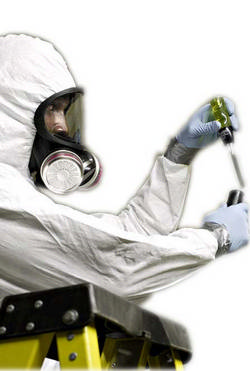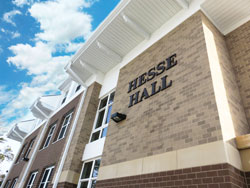The first floor of Howard Hall underwent an asbestos abatement which lasted for five days at the end of December. Amid the process, public access was prohibited. Facilities Management dis-covered the problem as a result of loose tiles damaged by water infiltration.
Patricia Swannack, Vice President for Administrative Services, says that knowledge of what to look for is important when dealing with the suspicion of asbestos. “In our experience, we are aware of certain things that might indicate the presence of asbestos and that it can be hazardous if not properly handled.”
The indicator, in this case, was the dimensions of the tiles present in the affected area. According to the New Jersey Department of Health website, asbestos has been linked to specific tile dimensions that are used in flooring. Those dimensions are nine feet by nine feet and some 12 feet by 12 feet tiles. To be certain that asbestos was in fact in the tiles of that particular part of Howard Hall, samples were test-ed by an independent laboratory and confirmed present in minimal amounts.
In taking precautionary measures to assure proper removal of the tiles, the University hired an outside contractor who specializes in asbestos abatement. A second company was in tandem to further compliment the safe removal of the asbestos. “We also engaged Birdsall Engineering to monitor the work to ensure that the project was per-formed in compliance with established guidelines,” Swannack said. Those guidelines, enacted by The Occupational Safety and Health Administration (OSHA) and the New Jersey Department of Labor, not only enforce a stringent protocol of asbestos removal, but also accredit abatement companies to safe disposal of the building material.
The word asbestos alone can alarm the public, but it is important to remember that asbestos-containing materials are safe as long as they are in sound condition and untouched. According to the U.S. Environmental Protection Agency’s website, the problem with asbestos usually occurs during remodeling or demolition when the disturbance can cause the microscopic fibers to become airborne and cause a threat to the public’s health. If the asbestos is considered friable, inhalation of the material poses problematic respiratory repercussions. Friable asbestos material is an element that, when dry, can be easily granulated and disintegrated by hand into a powder.
Asbestos does serve several beneficial uses in the building industry. The most important one being its ability not to burn in the presence of fire. The EPA’s web-site also credits it with being a poor conductor of electricity, an excellent thermal insulator and an impressively non-corrosive material. The fact that it does not corrode explains why the material still exists in buildings which are 75 to 100-years-old.
Jess Rinaldi, a sophomore, was pleased to hear about the University’s prompt and attentive response to the problem. “It makes me feel safe that they [the University] acted in a timely manner and hired professionals to do the job,” she said. “It reiterates the high standard of safety here and that is a comforting thing.”
To make certain Howard Hall was ready for the return of students, faculty and staff after winter break, air samples were conducted with exemplary results which are needed to pass the OSHA and NJ Department of Labor standards.




